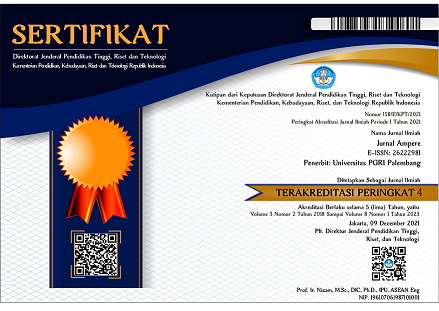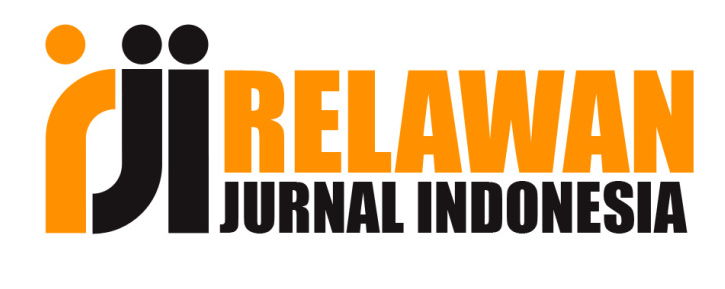Monitoring Konsumsi Daya Dan Pencegahan Kerusakan Pada Pendingin Udara Berbasis Iot
DOI:
https://doi.org/10.31851/ampere.v9i2.16552Keywords:
Monitoring Daya, Pendingan udara, IoTAbstract
Penyediaan energi listrik semakin terbatas, penghematan penggunaan daya pada pengguna listrik perlu dilakukan efisiensi dan menghindari pemborosan untuk mengurangi kerugian dari sisi pembiayaan. Pendingin udara sebagai salah satu beban listrik jika pendingin udara tersebut bekerja sudah tidak sesuai nameplate dari pabrik konsumsi dayanya sudah tidak sesuai, jika tidak segera diperbaiki akan mengalami kerusakan. Untuk mencegah terjadinya pemborosan daya diperlukan perangkat untuk memonitor arus listrik yang digunakan. Penelitian ini merancang dan membuat sistem monitoring penggunaan daya pada pendingin udara yang dapat dipantau pada Handphone sebagai bentuk penerapan teknologi IoT. Sistem yang dibuat dirancang untuk memonitor daya listrik dan pencegahan kerusakan pada pendingin udara. Tahapan penelitian dimulai dengan merancang wiring sensor pada pendingin udara;Wiring dan setting jaringan komputer dan Router; Pembuatan dan setting Web Server; Pembuatan program mikrokontroler ESP8266; Pembuatan program di Handphone, selanjutnya dilakukan uji coba dan dilakukan pengambilan data performa alat. Hasil sistem yang dibuat telah bekerja dan memproteksi pendingin udara jika terjadi kenaikan daya yang digunakan pada pendingin udara
References
H. Rahman And D. Handaya, “Prototype Sistem Monitoring Energi Listrik Untuk Ac Split Berbasis Nodemcu Dan Internet Of Things,” Jtera (Jurnal Teknologi Rekayasa), Vol. 6, No. 1, P. 25, Jun. 2021, Doi: 10.31544/Jtera.V6.I1.2021.25-30.
B. L. Dwi And R. A. T. Adnan, “Rancang Bangun Internet Of Things (Iot) Pada Sistem Pendingin Ruangan Berbasis Android,” In Prosiding Semnastera (Seminar Nasional Teknologi Dan Riset Terapan), Oct. 2022.
A. Ramschie, J. Makal, And V. Ponggawa, “Sistem Pengontrolan Kerja Peralatan Penyejuk Udara Berbasis Iot,” In Prosiding The 11th Industrial Research Workshop And National Seminar, Bandung, Aug. 2020.
“Sistem Monitor Dan Kontrol Listrik Secara Real Time Berbasis Mikrokontroler Real Time Monitoring Control System For Household Electrical System Based On Microcontroller.”
N. Haniifah And S. Hariyadi, “Simulasi Kontrol Monitoring Lampu Dan Ac Dengan Building Automation System (Bas) Berbasis Internet Of Things (Iot) Di Asrama Alpha.”
Z. K. Simbolon, “Real Time Monitoring Besaran Listrik Untuk Manajemen Energi Gedung Komersial Berbasis Web.”
Taryudi, D. B. Adriano, And W. A. Ciptoning Budi, “Iot-Based Integrated Home Security And Monitoring System,” In Journal Of Physics: Conference Series, Institute Of Physics Publishing, Dec. 2018. Doi: 10.1088/1742-6596/1140/1/012006.
C. D’ortona, D. Tarchi, And C. Raffaelli, “Open-Source Mqtt-Based End-To-End Iot System For Smart City Scenarios,” Future Internet, Vol. 14, No. 2, Feb. 2022, Doi: 10.3390/Fi14020057.
I. Gusti, P. Mastawan, E. Putra, I. Ayu, And D. Giriantari, “Monitoring Menggunaan Daya Listrik Sebagai Implementasi Internet Of Things Berbasis Wireless Sensor Network,” Teknologi Elektro, Vol. 16, No. 03.
F. Azzedin And T. Alhazmi, “Secure Data Distribution Architecture In Iot Using Mqtt,” Applied Sciences (Switzerland), Vol. 13, No. 4, Feb. 2023, Doi: 10.3390/App13042515.
B. M. Susanto Et Al., “Implementasi Mqtt Protocol Pada Smart Home Security Berbasis Web,” 2018.
J. S. A, R. Chakravarthy, And M. L. L, “An Experimental Study Of Iot-Based Topologies On Mqtt Protocol For Agriculture Intrusion Detection,” Measurement: Sensors, Vol. 24, Dec. 2022, Doi: 10.1016/J.Measen.2022.100470.
R. K. Kodali And S. R. Soratkal, “Mqtt Based Home Automation System Using Esp8266,” In Ieee Region 10 Humanitarian Technology Conference 2016, R10-Htc 2016 - Proceedings, Institute Of Electrical And Electronics Engineers Inc., Apr. 2017. Doi: 10.1109/R10-Htc.2016.7906845.
R. K. Kodali And K. S. Mahesh, “A Low Cost Implementation Of Mqtt Using Esp8266,” In Proceedings Of The 2016 2nd International Conference On Contemporary Computing And Informatics, Ic3i 2016, Institute Of Electrical And Electronics Engineers Inc., 2016, Pp. 404–408. Doi: 10.1109/Ic3i.2016.7917998.
Downloads
Published
How to Cite
Issue
Section
License
Copyright (c) 2024 Budi Nugroho, Rahmat Rahmat, Agung Suprianto

This work is licensed under a Creative Commons Attribution-ShareAlike 4.0 International License.

Jurnal Ampere is licensed under a Creative Commons Attribution-ShareAlike 4.0 International License.
Authors who publish with this journal agree to the following terms:
- Authors retain copyright and grant the journal right of first publication with the work simultaneously licensed under a Creative Commons Attribution License that allows others to share the work with an acknowledgement of the work's authorship and initial publication in this journal.
- Authors are able to enter into separate, additional contractual arrangements for the non-exclusive distribution of the journal's published version of the work (e.g., post it to an institutional repository or publish it in a book), with an acknowledgement of its initial publication in this journal.
- Authors are permitted and encouraged to post their work online (e.g., in institutional repositories or on their website) prior to and during the submission process, as it can lead to productive exchanges, as well as earlier and greater citation of published work.





